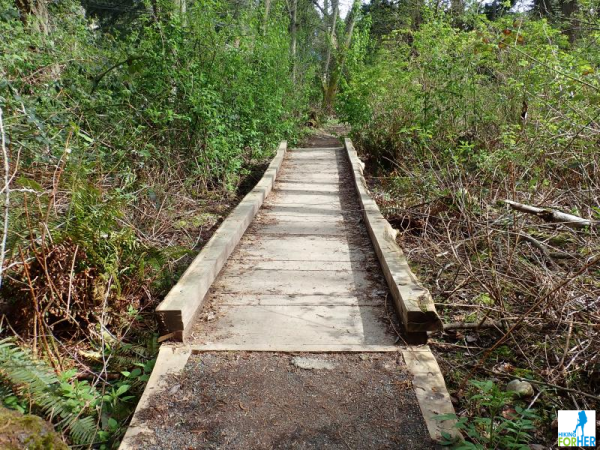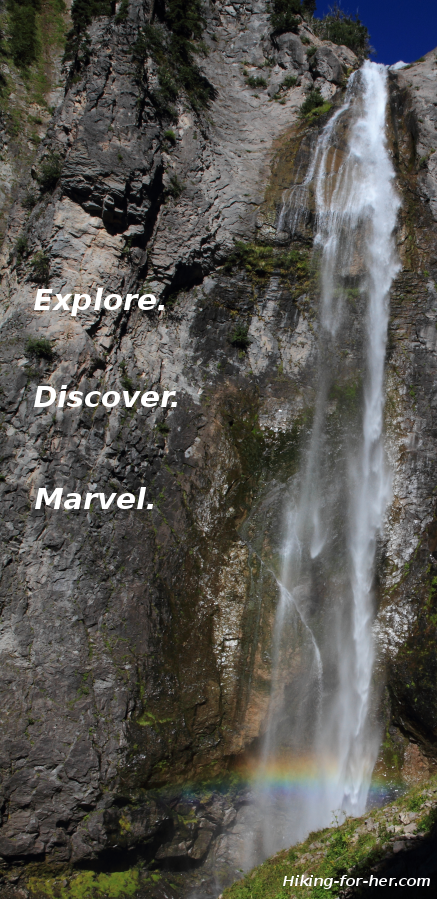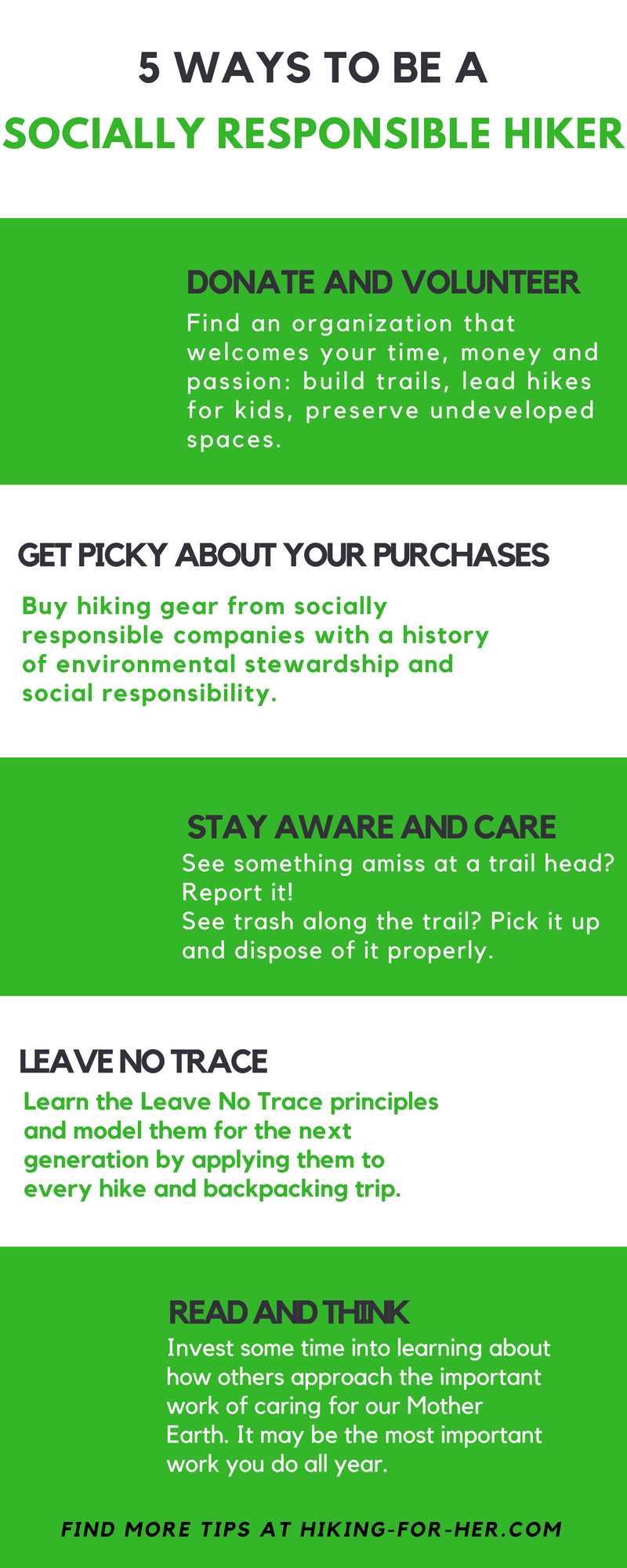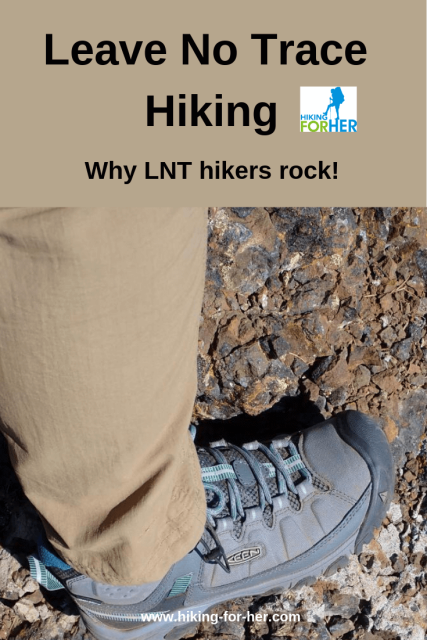
Leave No Trace Hiking Tips
For Hikers
By Diane Spicer
Leave No Trace hiking follows well established principles to keep your impact on the outdoors to a minimum.
Are there LNT police behind every tree, checking up on you?
No.
But your own motivation to keep the outdoors free of human interference or tell tale signs of occupation at campsites will grow stronger with every day (and night) you spend beneath the open sky.
Long story short...
It's all about respect.
If you're just getting started as a hiker, here's a quick explanation of the Leave No Trace principles.
Leave No Trace hiking principles
There are seven core principles in Leave No Trace hiking, all of them common sense and easy to practice.
For the official version, visit the Leave No Trace Organization.
You've found the abbreviated Hiking For Her version.
Leave No Trace hiking: it's about respect
The principles are grouped into two big chunks of respect:
RESPECT FOR ALL LIFE FORMS, INCLUDING YOURSELF:
- Plan ahead and prepare.
- Respect wildlife.
- Be considerate of other visitors.
- Leave what you find.
- Travel and camp on durable surfaces.
- Dispose of waste properly.
- Minimize campfire impacts.
These guiding principles aren't just for backcountry hikers.
Once you get hooked on this hiking thing, you'll find yourself applying them to your neighborhood park or any other outdoor space you visit in the front country.
And (hopefully) teaching them to the next generation!
LNT Tips
Using these principles as guiding lights for your actions on a backpacking trip or dayhike will become second nature to you (Mother Nature being your first love, right?).
Here are some tips for how to begin forming good LNT habits as a hiker.
RESPECT FOR ALL LIFE FORMS, INCLUDING YOURSELF
Before you go
Be meticulous in your planning.
Do extensive online research about the permits you need, the terrain you'll be crossing, upcoming weather patterns, the mileage you'll be able to handle, trail conditions, adequate food and water intake, and campfire regulations.
A prepared hiker takes care of herself and stays found and safe.
On the trail
Don't feed the bears, either accidentally or on purpose. If you're trekking through bear country, be bear aware and keep your campsite free of odors that might tempt a bear into bad behavior.
Use bear canisters to store everything with an odor.
A fed bear is a dead bear.
Do you really want that on your conscience?
Don't feed the squirrels, foxes, marmots or birds, either.
They've survived without your help, and need to do so after you take away your trail mix.
Wildlife respects the natural cycles in order to mate, reproduce and raise the next generation.
Keep your nose out of their business!
Don't disturb their nests, dens and game trails.
If you take photos, use a lens that allows you to keep your distance.
If you find a "lost"
baby animal, it probably isn't. Mom is away hunting, or you've scared her.
When you take a rest break on the trail, don't literally take it on the trail!
- Find a durable surface where you can sit, lounge, remove your boots, munch your peanuts, and dig through your pack without impeding the flow of other hikers.
Here are more Hiking For Her tips on Trail Etiquette. (free pdf download)
At your evening campsite
At your campsite, let this thought guide you to calm, quiet actions:
Everyone is here for the same nature focused reasons.
Loud rowdy neighbors are expected at a music concert but reviled in the
backcountry. Be as quiet as possible, especially between 9P and 7A.
Also note that campsite voices echo and bounce and
amplify. A "normal" speaking voice might be heard a fair distance away.
Hiking with dogs?
Hiking with dogs is as problematic as your dog is.
I know, I know, your dog is special and well trained.
But any dog gets crazy excited by the scent of deer or the dash of a squirrel across the trail.
Know the regulations permitting or denying you the privilege of hiking with your dog, and respect why they are in place.
RESPECT FOR PLACE
I feel somewhat sheepish about telling you to leave what you find, because I have been known to bring home bits of bone, goat hair, feathers, rocks and snail shells.
So I will take the high road and say that collecting freebies that land on the trail (mentioned above) is one thing, digging up plants or destroying a rock face to dig out a quartz crystal is quite another.
Pay attention to what's right under your boots
Use durable surfaces for travel and campsites, especially in fragile environments such as alpine or desert terrains where plants struggle to gain, let alone maintain, a literal foot hold.
Your feet may seem small in the vast outdoors, but to moss or lichen, they're immense and destructive.
Waste-ing away
Being a biological entity generates solid and liquid waste.
- These tips for hiking hygiene will get you started thinking about how to keep yourself and the environment clean as you void your blood, sweat, tears and poop.
Humans also generate waste during food preparation.
If you've done your planning (see the first principle) you've already minimized plastic or foil packaging.
You've got the backpacking kitchen essentials you need.
Also:
- You have a "food loss prevention"
plan in mind to deal with your wild neighbors.
- You cook only the amount
you need, with no need for storing it overnight.
- You don't leave food behind to make trouble for the next campers: no dumping bits of rice or beans on the ground as you wash up.
- You wash dishes and dispose of gray water properly (tips here).
Gooed campsite etiquette for hikers
- If you brought it in your pack, that's the way it leaves, too. No digging holes, no throwing it into the lake, no hiding it under a rock.
- The idea of a campfire is quaint, and deeply rooted in American folklore about what it means to be outdoors. Be sure a fire is permitted
before you burn down an entire county.
- When a fire is permitted, be cautious about starting one in dry, windy conditions.
- Backpacking stoves
are the most respectful way to go. Tips for the best ones here. In my humble opinion: Bring your own
fuel, control the amount of risk to the environment, and go star gazing
rather than staring into a fire at the end of the day. Or try dark sky night hiking!
More LNT ideas
For even more ideas on how to be on the land without leaving a trace, read these Washington Trails Association Leave No Trace hiking tips.
Expect an answer - I read and respond to every email.
And here's a thought...
Why not go one better?
Erase traces of past human activity that add nothing to the back country experience.
In fact, they destroy the back country experience of exploration and discovery.
Lots of examples come to mind:
- Old tin cans and bottles tossed in streams
- Fire rings that immediately draw your eye
- Garbage caught on downed trees or snags: fishing lures, discarded socks, anything plastic
I'm sure you've got your own examples.
Carry an empty plastic bag with you and fill it up on your way back to the trail head.
Squeamish about picking up litter with bare hands? Bring a lightweight pair of small tongs.
If no one else says thank you, at least you'll know that you have my sincere thanks for your efforts to keep the wilderness (or county park, anywhere you hike) pristine.
- Your efforts to practice Leave No Trace hiking are appreciated.
Handy LNT infographic
Here are more ways to be an aware, socially responsible hiker:
What can you do when you see a
LNT violation?
Being combative or confrontational can escalate a situation and result in unintended outcomes.
Instead, you can use a technique called the authority of the resource approach.
It's a five step sequence to call upon when you spot someone tossing orange peels on the trail, tearing limbs off trees for a less than minimal impact camping site, or other acts that have permanent consequences.

Leave No Trace Hiking:
a romantic, yet practical, idea
If you've ever yearned to melt into the landscape without a trace, living by your wits (and the technology in your pack) while glimpsing wildlife and marinating in awe inducing vistas, you're my kinda hiker!
Apply the LNT principles to make sure I can't trace you.
And rest assured that I'm returning the favor on every hike.
- Because fossilized orange peels and brown toilet paper aren't what I want to see on the trail.
- And I'm not interested in seeing your initials on the tree outside my tent.
I'm sure that you and I agree on the wisdom of Leave No Trace hiking principles.
Glad you're sharing the trail, Leave No Trace Hiking virtual trail buddy!
Home page > Best Hiking Tips >
Leave No Trace Hiking
|
I get emails all the time about what I wear, eat, carry and love to use on the trail. That's
why I provide affiliate links to you: the best gear that I use myself and have seen used by other hikers is instantly
available for your consideration, and the gear company sends a few
pennies per dollar to this reader-supported hiking website. There is no added cost to you! Everyone ends up a winner: Great gear for you, strong gear companies, and more free hiking tips for everyone. Thanks very much for your support. It's warmly and sincerely appreciated. It also helps send these hiking tips to all your virtual trail buddies around the globe. |
 |




